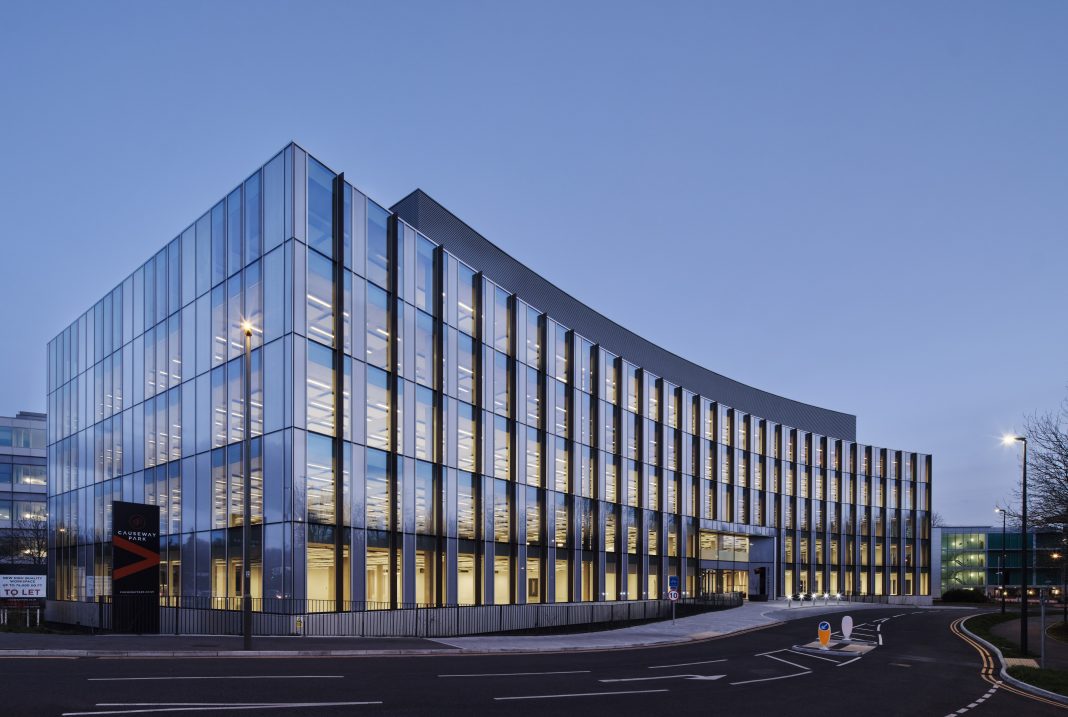A case study of No. 1 Causeway, Staines, by James Ward, project director and associate director at Arup
While the pandemic undoubtedly presented numerous challenges for the architecture and construction industries alike, no more so was this the case than in the commercial office sector. Working from home restrictions have been in place – on and off – since March 2020, amidst various lockdowns over the past two years. As such, our concept of the traditional working life dynamic – in terms of how and where we carry out our day job – has been irrevocably altered and with it: the post pandemic office may never be quite the same.
The “death of the office” isn’t upon us just yet, though. As we embrace the hybrid working structure, it looks like they’re here to stay. In fact, last month, data revealed London’s offices were at their fullest since the start of the pandemic, with 42% occupancy. But the wants and needs of employees are likely to keep evolving which means post pandemic office space will keep shifting too.
This presents exciting challenges and opportunities for those working in the post pandemic office. For our team of engineers at Arup, designing and developing No. 1 Causeway, a crescent-shaped office building in Staines, Surrey, amidst this environment provided a chance to reflect, improving how and what we design in the sector in the long-term.
The building’s design – a repeating façade punctuated with integrated vertical fins – is sympathetic to the English tradition of the crescent followed by John Nash, John Wood and Neave Brown. However, despite its influences heralding from Regency architecture, its focus is on the future.
Remaining agile and managing a project during a pandemic
A pandemic is an exemplary way to demonstrate the delicate balance between delivering contemporary and future use requirements. With the upheaval caused by lockdowns demanding effective management and delivery of construction under restrictions while constantly remaining open-minded to changing plans and potential uses throughout the project, No. 1 Causeway is a prototype project.
Forming the new entrance to the next generation campus, Causeway Business Park, the space was specifically developed in response to the increasing demand for commercial areas in the South East region.
Just over six months later, the pandemic hit. As a result, the commercial objectives of the project pivoted. The team had to develop a space that aligned to pandemic sensibilities, adapting plans to ever-changing lockdown measures. Similarly, it became paramount to prepare it for multiple use while futureproofing against potential virus variants.
In response, anti-viral design measures were integrated into the building to meet contemporary demands and offer safety and comfort in equal measure. These included UV air filtration, touch-free lifts and antimicrobial ironmongery and sanitary ware.
Developing future-thinking office buildings
The ambition is for No. 1 Causeway to create opportunities for the vibrant, connected, mixed-use community it serves, while also allowing enough manoeuvrability as demands and needs change in the future. This is delivered via its 11,180sq m space, which has five storeys of flexible workspace for multiple tenants.
The large efficient floorplates provide an uninterrupted space that can be adapted over time to suit a wide variety of occupiers.
Ensuring the use of space was maximised to its full potential also factored into the design: the floorplan is a crescent shape, stepped to the east to allow for an increase from a width of 24m to the south to 30m at the north.
Efficient methods of construction were also vital to ensure project completion in good time. For example, the core design was delivered as an expressed kit of parts, with prefabricated elements in the façade and structure as well, helping to reduce the length of the programme and associated risks.
Incorporating sustainability into the post pandemic office and commercial spaces
Despite being developed with the pandemic front of mind, the team didn’t lose sight of the sustainability requirements for No. 1 Causeway.
The ambition for the façade – which is a simple repeating module, set out on a 1.5 grid with a vertical rhythm – is to target a 30% solid to void ratio, all the while maintaining a generous feel internally and externally. Doing so aims to minimise energy usage by reducing heat loss and solar gain. Currently, the building achieves a whole building solid to void ratio of 30%, with a typical bay on the west elevation achieves a ratio of 37.5%.
Extending the link to the natural world beyond the building into the surrounding landscape of the nearby Thames was also vital to the future use of the space. This has encouraged new growth and wildlife, with planting including flood tolerant, robust and easily manageable willows.
Furthermore, by providing optimal internal environments for the wellbeing of the occupants, No. 1 Causeway achieved BREEAM Excellent standard.
Next steps
The true impact of the pandemic on the way we work and design office buildings is yet to fully emerge – and may not for many years to come. To accommodate such uncertainty, that our industry must remain flexible through innovative and agile design. This will ensure that the next generation of commercial spaces, such as No. 1 Causeway, will be prepared for anything. By factoring in changing use, demands and needs, these projects will truly deliver on a multiple purpose ambition, serving a broad spectrum of society.
James Ward
Project director, No. 1 Causeway
Arup
Tel: +44 (0) 20 7636 1531

















